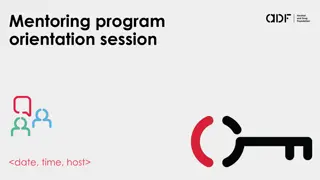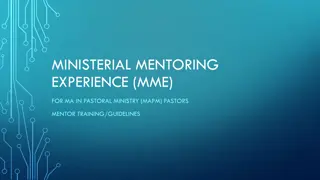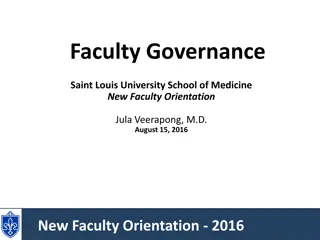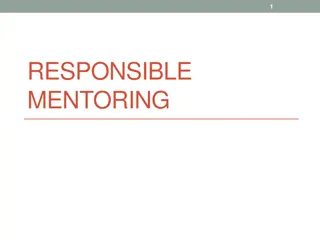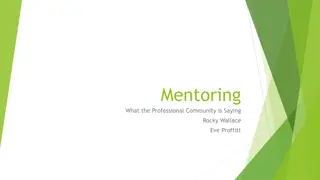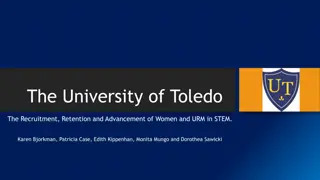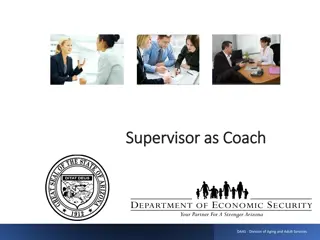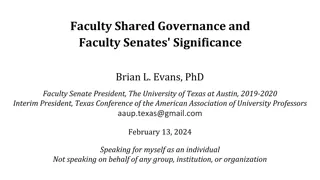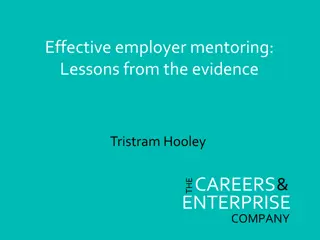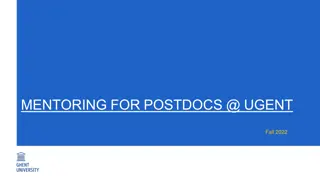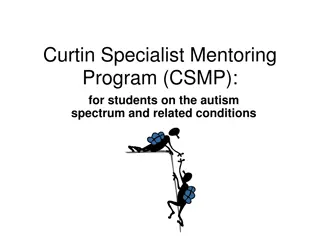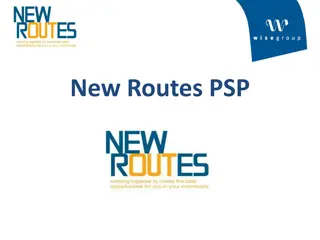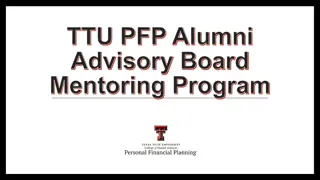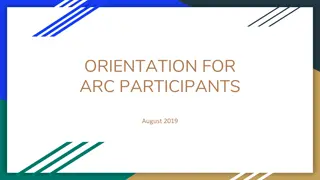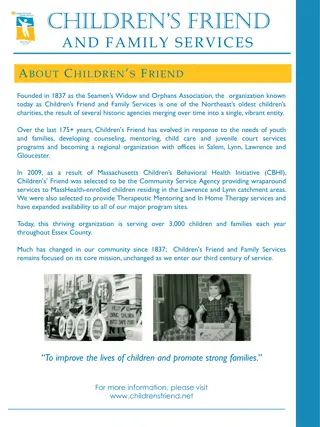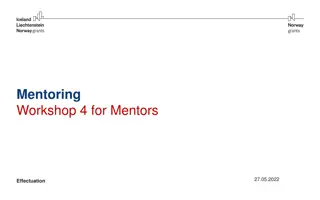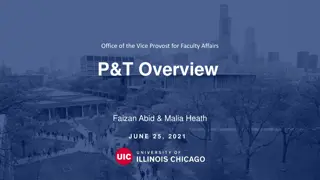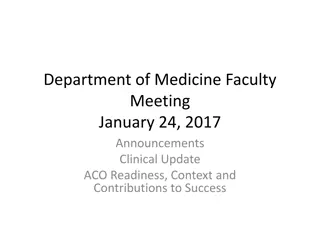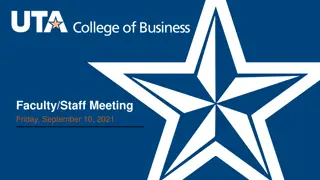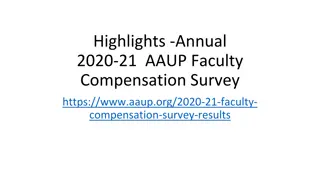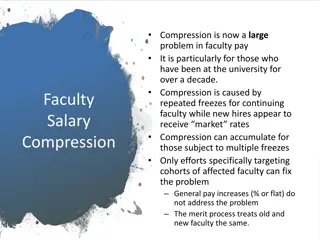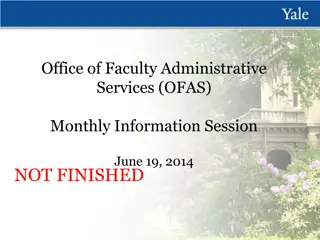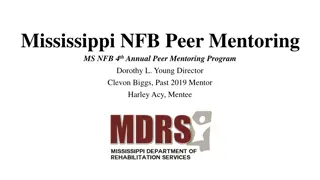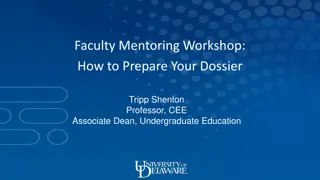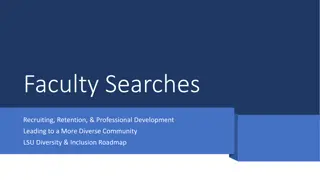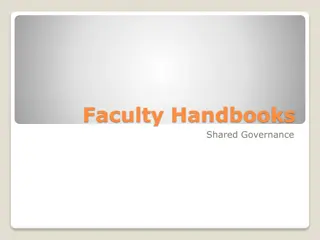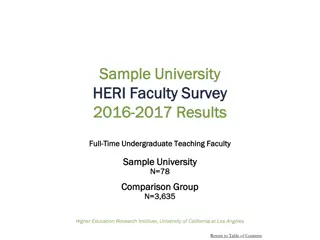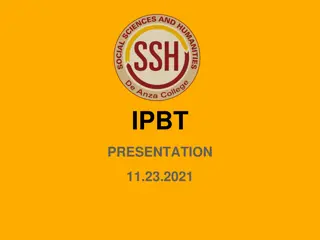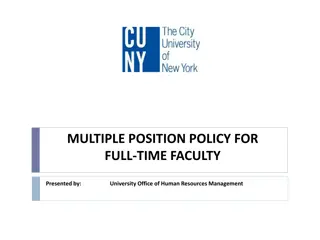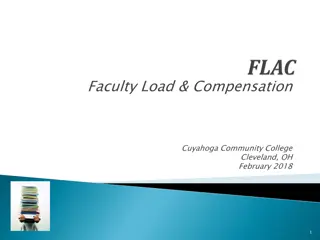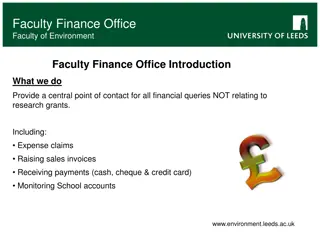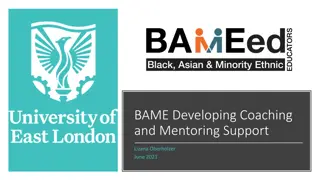Faculty Mentoring Workshop in Health and Human Services
Workshop agenda covers key topics such as PAF and WPAF, early tenure and promotion, ARTP policies, retention processes, and review timelines for probationary faculty members. The session aims to provide guidance and support for new faculty members in their career advancement within the academic setting at Sacramento State.
Download Presentation

Please find below an Image/Link to download the presentation.
The content on the website is provided AS IS for your information and personal use only. It may not be sold, licensed, or shared on other websites without obtaining consent from the author. Download presentation by click this link. If you encounter any issues during the download, it is possible that the publisher has removed the file from their server.
E N D
Presentation Transcript
College of Health and Human Services RTP Workshop New Faculty Mentoring November, 2023
Agenda Overview PAF and WPAF Early Tenure and/or Promotion Secondary Committee Dean s Review Tips Quality v Quantity
Retention, Tenure and Promotion (ARTP) Policies Memorandum of Understanding (MOU) For Unit 3 Faculty Sacramento State ARTP Policy Presidential Memorandum FSA 00-11 College ARTP Policy Department ARTP Policy
Retention Tenure Promotion (RTP) Flow Process Primary Level Review Department Committee Independent Department Chair s Review Recommendation Forwarded Secondary Level Review College Committee Ten-day rebuttal period after each review Recommendation Forwarded Dean s Review Recommendation Forwarded Provost & Vice President Academic Affairs Decision Forwarded Faculty Member
NEW Probationary Faculty P-1: Newly hired probationary faculty members without credit towards tenure. P-2*: Probationary faculty in their first year, hired with one year toward tenure. P-3*: Probationary faculty in their first year, hired with two years toward tenure, or second year hired with one year toward tenure Note: All P-1, P-2*, and P-3* faculty in their first year of employment at Sacramento State are evaluated in the Spring Semester of their first full year of tenure-track employment.
P1/P2*/P3* Review First year faculty (P1, P2*, P3*) will undergo an abridged* review during the spring semester of their first full year of tenure-track employment. File closure deadline is February 2, 2024. Primary committees will complete an evaluation letter by February 16, 2024 (to be distributed by Dean s office to faculty by February 19). Faculty will get a retention decision letter from the Dean by April 3, 2024. *meaning a shortened timeline and only one semester s worth of materials
Probationary Faculty P-1: Newly hired probationary faculty members without credit towards tenure. P-2: Probationary faculty in their second year, or first year hired with one year toward tenure. P-3: Probationary faculty in their third year, or first year hired with two years toward tenure, or second year hired with one year toward tenure P-4: Probationary faculty in their fourth year. Final decisions for retention at this level rest with the Provost. P-5: Probationary faculty in their fifth year. P-6: Probationary faculty in their sixth year. Faculty in this classification must be reviewed for tenure and/or promotion.
Timelines Six years standard time to request Tenure and promotion to Associate Professor Tenure review required by the sixth probationary year (P6) Promotion reviews are optional; must indicate in writing if not desired Must be reviewed every five years after tenure
Personnel Action File (PAF) Volume 1 Official Personnel File Permanent Custodian is Dean Permanent Location is OneDrive Access Can request placement of items in file through Dean s Office Only the Dean places items in the PAF Cannot be removed from Dean s Office Control
Working Personnel Action File (WPAF) 23/24 Format - OneDrive Developed by faculty member Timeline of materials to include: Retention to Tenure/First Promotion: from appointment date until file closure Subsequent promotions: from last promotional review closure to current file closure
Working Personnel Action File (WPAF) Documents added by College: Appointment letter Access log and transmittal sheets Appendices Verification of Contents Current Reviewer Evaluations Past Reviewer Evaluations College inserts student evaluations At the end of review cycle, the Dean updates the PAF and WPAF is returned to candidate Evaluations, CV, transmittal sheets, index, and appendices
Organization of WPAF 4.08E of UARTP Faculty under evaluation and custodian of PAFs shall place materials in the WPAF in the following order: 1. Access log 2. Verification of WPAF contents 3. CV/resum (current CV/resum and CV/resum from either the original appointment (for tenure and promotion to Associate Professor) or from the last time the faculty member was promoted (for promotion to Full Professor) 4. Current RTP Evaluations 5. Past RTP evaluations 6. RTP narratives/summaries/reflective statements/personal action plan/faculty development plan (as appropriate for each College) addressing: a. Teaching effectiveness b. Scholarly and creative activities c. Service (contributions to the community and to the institution)
Organization of WPAF 4.08E of UARTP 7. Index of items in following section of binder (A-E) a. Evidence for teaching effectiveness i. Student evaluations ii. Peer evaluations; if any; iii.Syllabi (at least one for each course taught) iv.Other evidence of teaching effectiveness b. Evidence for scholarly and creative activities c. Evidence for institutional service d. Evidence for community service e. Other materials required by the College ARTP policies not included elsewhere (including letter of appointment, additional resumes, previous indices, etc.)
Suggested File Naming Convention Match number on uploaded document to index: Note: Please adhere to a 30 character limit for file all names.
Areas of Review Teaching Effectiveness Scholarly and Creative Achievements Contributions to the University Contributions to the Community
Items Used for Review Student Course Evaluations for all courses Summer is not included, unless contractually obligated (AuD) Peer Evaluation or Visitation (per departmental practices) Course materials Syllabus for each course taught during review cycle Evidence of pedagogical excellence Evidence of accomplishment in Scholarly & Creative Activity (appropriate to your discipline/appointment) Service to the campus, community, profession
Index A record of activities and materials in the WPAF in outline format Covers time period being reviewed Use asterisk to indicate which items are in file Items without asterisk can be called for at any review level with 24 hour notice Newest items first
Resume/Curriculum Vitae Current educational and professional experience Get in the habit of updating each year This is important, it may be the first thing considered
Letter of Transmittal State the action requested (retention, or tenure and/or promotion) Indicate activity specified as condition of employment, i.e., doctorate Summarize activities documented in file for each of four evaluation categories Help guide and focus the reader Include preferred pronoun (not required)
WPAF Closure Must verify file contents and close WPAF by signing verification form After this, no other items may be added or removed from the WPAF, Dean s Office inserts Secondary and Dean Reviews Once closed, submitted to Primary Committee for review
Role of Department Chair Per University Policy: Supervise the evaluation of department faculty and staff as required by departmental personnel procedures.
Early Promotion Outstanding performance in teaching; appropriate academic preparation; outstanding in 2 of the other 3 areas of evaluation What is Outstanding?
Early Tenure Performance substantially beyond that required for tenure after normal 6-year probationary period Activities bring widespread recognition to individual and university from academic community and / or general public Outstanding teaching, appropriate academic preparation; outstanding in 2 of the 3 remaining criteria
Secondary Committee Ensures evidence justifies recommendation of Primary Committee Ensures Primary Committee follows policies and procedures Conducts independent evaluation
Secondary Committee Composition One tenured Full Professor from each unit in College (Committee A or B); tenured Associate Professors may serve on Committee A FERP faculty eligible if during term of service Members may not serve on both Primary & Secondary Committee One Alternate elected from each unit Alternates may not serve simultaneously on Primary & Secondary Committees
Deans Review Separate and independent from Primary, Chair (if applicable), and Secondary reviews P4, P6, and Tenure and/or Promotion go to Provost for final decision
Ten Day Rebuttal Period The faculty unit employee may submit a rebuttal statement or response in writing and/or request a meeting be held to discuss the recommendation within ten (10) [calendar] days following receipt of the recommendation. A copy of the response or rebuttal statement shall accompany the Working Personnel Action File and also be sent to all previous levels of review. This section shall not require that evaluation timelines be extended.
And now for A Discussion About Quality vs Quantity
Quantity Just enough to make your case, not an ounce more Anything you list in your index as an accomplishment or as evidence of your excellence can be requested for review. Therefore, not everything needs to be included, just the best of it. Consider including no more than one piece of evidence for each achievement.
Quality Always a challenge Demonstrated achievement in teaching, scholarship/creative activity, and service. Grounded in academic and disciplinary standards. Know your discipline and how it is evolving. Talk with your chair, colleagues, deans, mentors.
Tips Don t vary order for presentation of material Clearly label each evaluation category Label each item so relevance is apparent Items can only be used in a single category, however, some items cross categories Use mini letter of transmittal and index
Tips Make file organized and easy to follow Carefully choose what to include, if you included it, you want it to be considered Put most recent items first Read and respond to previous reviews If no teaching assignment, memo from supervisor indicating work done
Contact Dean Maguire maguirem@csus.edu Heather Crummett, Budget Analyst crummetth@csus.edu


